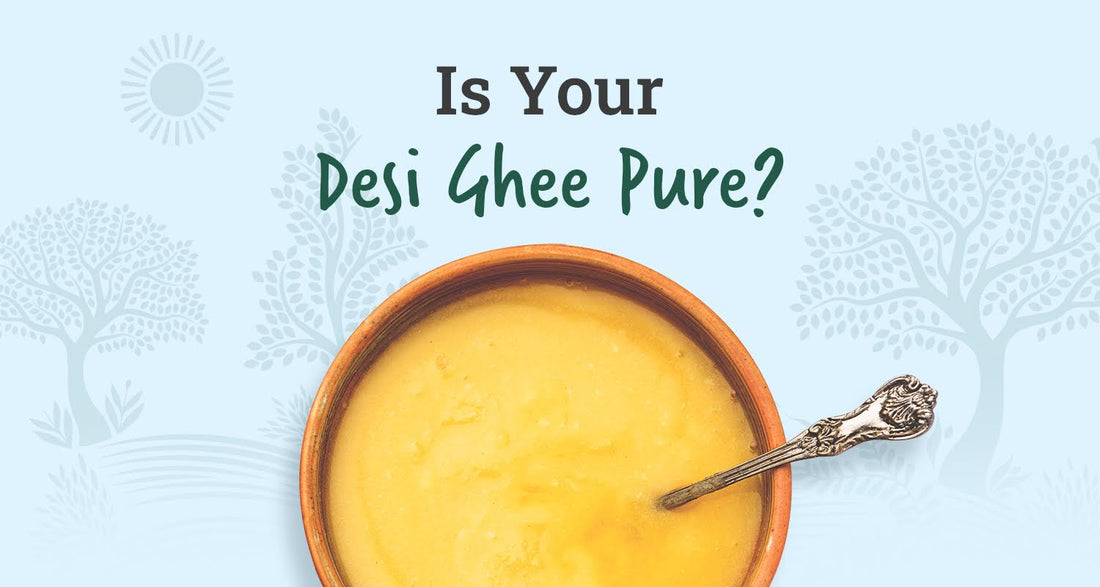
Test Purity Of Ghee At Home: Everything You Need To Know.
Share
The Million Dollar Question: Is Your Ghee Pure Or Adulterated?
For Indians, desi ghee is an emotion. Our ghee obsession has much more to do with making our parathe, idli, rice or dal more delicious. Traditional Indian diets and Ayurveda have long celebrated ghee for adding both flavour and nourishment to our plates.
It’s rich in essential fat-soluble vitamins like A, D, E, and K, and loaded with healthy fatty acids that support overall well-being.
But here’s the bitter truth we often ignore: not all ghee is truly pure.
As more people wake up to the benefits of A2 ghee and traditional food practices, demand has surged. Sadly, this rise has led some manufacturers or middle-men to cut corners. Many now resort to adulterating ghee with vanaspati, animal fats, or even mineral oils to boost profits.
If you care about what goes into your family’s meals, this blog will help you identify adulterated ghee with ease, so you can make safer, healthier choices.
Why Ghee Adulteration Is a Serious Concern:
- In Barmer (Rajasthan) during the 2024 festive season, authorities seized 3,100 kg of adulterated ghee, raising red flags about quality control in regional supply chains
- In Gujarat’s Palanpur, the state FDCA confiscated over 2,700 litres of suspected spurious ghee in April 2024. Some packed in branded containers and suspected of containing vanaspati or palm oil blends
- According to industry insiders, up to 70% of ghee sold in parts of India may be substandard or adulterated, particularly during high-demand periods.
- The high-profile Tirupati laddu ghee case, still under investigation, uncovered the use of animal fat and palm oil–based adulterants supplied to temple authorities. These cases prompted a Supreme Court-led probe and Special Investigation Team involvement.
3 Easy Tests To Check Purity Of Ghee At Home
1. Opacity Test (Time-Based Purity Check)
What it tells you: How quickly ghee solidifies after melting.
-
Pure cow ghee takes over 35 minutes to become opaque at room temperature (25°C).
-
Adulterated ghee with vanaspati/lard solidifies in just 2–7 minutes.
-
Buffalo/goat body fats may take just 18 seconds.
Note: This test may not detect vegetable oil adulteration.
2. CTD (Critical Temperature of Dissolution) Test
What it tells you: At what temperature ghee becomes cloudy in an alcohol solution.
-
Pure cow ghee shows turbidity between 51.6–54.6°C
-
Buffalo ghee: 52.4–56.2°C
-
Adulterated ghee: Shows turbidity only at much higher temperatures (up to 72°C)
Best for detecting over 15% adulteration
3. Fractionation Test (Crystalization Time Test)
What it tells you: How fast ghee crystallizes under controlled cooling.
-
Pure ghee crystallizes in about 19 minutes at 17°C.
-
Ghee mixed with 10% body fat will crystallize faster—in just 3–15 minutes.
Advanced method: Combine this with a Butyro-Refractometer (BR) reading to detect impurities as low as 10%.
A Simple Checklist To Make Sure You Are Choosing The Right Ghee
When buying A2 ghee or cow ghee, keep these quick checks in mind:
- Check the source: Is it made from A2 milk from indigenous cows?
- Look for Bilona or traditional methods: Cold-churned ghee retains nutrients and purity.
- Check packaging: Prefer brands using glass bottles over plastic.
- Ask for test reports: Trusted brands like Anveshan Ghee share lab-tested results.
- Smell & texture: Pure ghee has a rich aroma and granular texture.
Why Is A2 Cow Ghee Better?
With rising concerns around food quality, more and more households are choosing pure, unadulterated ghee. Especially A2 ghee made from native Indian cows.
Benefits include:
-
Better nutrient absorption (thanks to fat-soluble vitamins)
-
Improved heart health & gut health
-
Ideal for children, elderly, and those with lactose intolerance
-
Ayurvedic properties: balances vata, pitta & kapha doshas
What Makes Anveshan Ghee Different
At Anveshan, purity isn’t a buzzword. It’s a promise.
-
Made from A2 milk of free-grazing, native cow and buffalo breeds.
-
Prepared using the traditional Bilona method, upgraded with modern technology.
-
Lab-tested to ensure 100% purity. No vanaspati, no body fats, no shortcuts
-
Packed in sustainable glass jars for long-lasting freshness
This is pure cow ghee the way it was always meant to be.
Ghee That You Can Trust
Your kitchen deserves more than just "ghee". It deserves the purest ghee, the kind your grandmother trusted.
Don’t just go by brand labels or price tags. Use these home tests, check sources, and choose brands like Anveshan Ghee that are transparent about what goes into every bottle.











 You saved ₹-48 on this order
You saved ₹-48 on this order